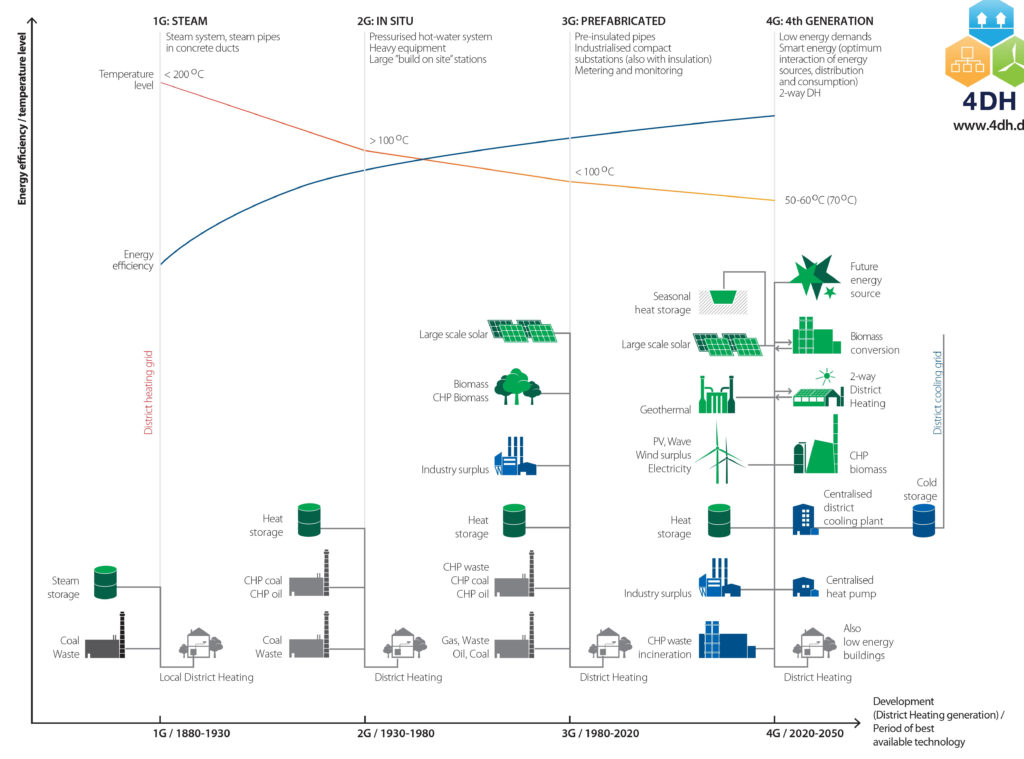Getting closer to a zero-carbon future is a primary policy goal, along with lowering energy costs and minimising fuel poverty. Katerina Nika, Head of Marketing & Communications at SAV Systems, explains why 4th generation heat networks will play a crucial role.
One of the key benefits of heat networks is their ability to incorporate different sources of heat and facilitate use of renewables. Heat networks currently supply about 11% of global space and water heating needs, mostly fuelled by either coal or natural gas, while the national renewable energy share can range from 1% in China to 42% in Denmark. Use of renewables is increasing rapidly though, also in the UK.
Given this increase, it’s clearly essential that the heat networks of the future have the flexibility to incorporate heat sources based on renewable power. Heat networks will need this flexibility to respond to increasing changes in energy supply and demand — particularly the increase in intermittent renewable energy.
Thus, incorporating fourth generation (4G) design is required if heat networks are to have a real environmental and social impact. These impacts include the potential for reducing fuel poverty. On average a heat network user will pay £100 less on their annual heat bill compared to non-heat network users. However, it is estimated that less than 2% of the UK’s total housing stock is currently connected to a heat network or central plant system.
4G heat networks
A 4G energy centre will typically use a combination heat sources. These may include combined heat and power (CHP), surplus heat from local industry or waste incineration, wind, solar thermal, photovoltaic, heat pumps, electric cells, biomass, hydrogen and even electric boilers.
In parallel, buildings are being designed with decentralised, built-in renewable energy sources, thereby increasing the overall complexity of the ‘energy picture’ as buildings become ‘prosumers’ — both consumers and producers of energy. Ultimately, we are moving to a scenario with energy from a diverse range of sources flowing to and from buildings throughout the course of each day. Accommodating this growing complexity requires the inherent flexibility and integration that is embodied in the 4G heat network design philosophy.
Designing for 4G
It is now well understood (and recognised in the Heat Networks Code of Practice published by the Chartered Institution of Building Services Engineers) that heat networks operate more efficiently at lower temperatures, especially where low carbon sources are in use. In doing so, they will facilitate inclusion of current and future renewable and low carbon technologies that require lower operating temperatures.

Building design
The building designs in a 4G heat network philosophy start with the inherent flexibility to evolve with time and leverage new opportunities for energy and carbon savings as they become available. They should be as energy efficient as possible using good levels of thermal insulation, natural daylight, heat recovery, intelligent controls etc.
Where appropriate, buildings should also incorporate local heat and power generation technologies in combination with wind, solar thermal, photovoltaic, air or ground source heat pumps, electric boilers and thermal storage. Heat emitters (e.g. radiators) in these buildings will need to operate at lower temperatures than is traditionally the case. Therefore, good thermostatic control of radiators becomes increasingly important.
4G heat networks also need to incorporate intelligent metering to help optimise the operation of the energy centre, identify opportunities for improvement and help consumers adjust their behaviour.
Managing intermittency
One of the main challenges posed by intermittent energy sources is that times of highest generation may not coincide with times of maximum demand, creating a need for reliable and cost-effective energy storage. As much of this surplus will be electrical energy (from wind, solar, tidal) batteries are often seen as the obvious storage solution; however, current studies show that storing energy as hot water can be more than 100 times less costly than battery storage. 4G heat networks are able to exploit surplus electrical power by converting it to heat energy (e.g. via heat pumps) for storage in thermal stores.
Making 4G heat networks a reality
Heat networks tend to be either large district heating schemes or small block heating schemes. For larger district heating schemes, a low-cost heat source, such as waste heat, is a great start to minimise carbon emissions, cost and disruption.
Where such low-cost heat sources are not available it is generally more feasible to consider smaller block/communal schemes, which may vary in size from around 20 dwellings to large multi-dwelling developments. These require only installation of heating and hot water pipes in the building, creation of an energy centre (typically on the same site — plant room) and provision of heat interface units in each space being heated.
With an overarching need to reduce carbon emissions, the necessary policy framework goes hand in hand with planning and managing a transition to 4G heat networks that combine and utilise production and consumption between heating/cooling, electricity, gas and transport grids. Such sustainable networks will focus on the wider use of low-grade renewable and waste heat sources, with the ability to store the surplus energy and manage the intermittent energy sources efficiently.
In short, our energy systems are continuously evolving, and our heat networks will play a key part as we move towards 4G.









